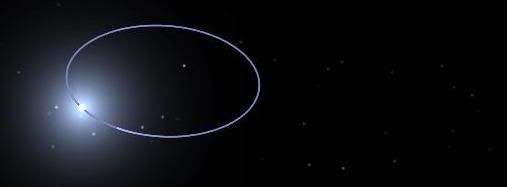I apologize for the delay in answering, I had to go to sleep for the night X_X.
Slartibartfast wrote:I'm confused. =P Shouldn't it orbit the Hadar barycenter?
Yeah, you could probably do it that way too. That might be easier, lol.

Slartibartfast wrote:Also, to clear something up that's confusing.. you said you took the semimajor axis from the paper, but you have a value of 2.391 and the paper said 25.30. How did the latter number translate into the former?
The paper gives the semi-major axis in milliarcseconds (mas). This is a measurement of how much of the sky it occupies, rather than a physical size. So the true seperation would depend both on the 25.3 mas and the distance. Using an Excel sheet to do that math for me, I derrived 2.391 AU.
Slartibartfast wrote:Sorry to pester you with so many questions
It's quite alright, I don't mind.
Slartibartfast wrote:but I can't learn if I don't ask, eh?
Exactly.

Slartibartfast wrote:Also, you have the SIMBAD distance as 524.9597. I've spent the last hour or so combing SIMBAD for a distance and I seem to be too bloody ignorant to find one. Where should I look?
As the Earth moves in it's orbit around the sun, the apparent positions of the stars appear to change. This tiny amount of change is called the parallax. The higher the parallax, the more the stars appear to move, and the closer they are. To get distance from parallax, divide 1000 by the parallax (if it's in milliarcseconds, as it is in SIMBAD). This is your distance in parsecs. Now multiply that by 3.26 to get light years (alternatively, you can divide 3260 by the parallax to get light years).
Alright, with the new data you posted. The AB AA barycenter has a total mass of 25.4 solar masses, and B has a mass of 3.9 solar masses.
In any binary system, the distance between two objects (whether it be two stars, or a star and a barycenter, or two barycenters) is a ratio inversely equal to the ratio of their masses.
An object with 10 solar masses and an object with 1 solar mass are orbiting each other with a seperation of 11 AU. The 10 solar mass object will orbit 1 AU from the barycenter, and the 1 solar mass object will orbit 10 AU from the barycenter.
To solve for less, even, numbers, you can set it up like this.
x / y = 6.51282051282
x + y = 110
where x is the semi-major axis of the less massive star, and y is the semi-major axis of the more massive star. The more massive star or barycenter in this case, always has a smaller semi-major axis because it is not moved as much by the less massive star. You can solve this as any sort of system of equation.
Rearrange -> y=110 - x
Substitute -> x / (100 - x) = 6.51282051282
After solving, you should obtain 86.6894197952 AU for x.
Since x + y = 110, and x = 86.6894197952,
86.6894197952 + y = 100.
y = 23.3105802048 AU.
Updating the code with this information gives:
Code: Select all
# Bet Cen AA-AB/B
Barycenter "BET Cen"
{
RA 210.9558521
Dec -60.3730394
Distance 524.9597 # using SIMBAD distance, rather than the paper.
}
Barycenter "BET Cen A"
{
OrbitBarycenter "BET Cen"
EllipticalOrbit {
Period 250
SemiMajorAxis 23.3105802048
Eccentricity 0.0 # Unknown.
Inclination 0 # Unknown.
AscendingNode 180 # Unknown.
ArgOfPericenter 0 # Unknown.
}
}
68702 "BET Cen AA"
{
OrbitBarycenter "BET Cen A"
SpectralType "B1III"
AppMag 0.61
EllipticalOrbit
{
Period 0.977412731006
SemiMajorAxis 2.391
Eccentricity 0.819
Inclination 172.66
AscendingNode 31.31
ArgOfPericenter 318.16
MeanAnomaly 40.89
}
}
"BET Cen AB"
{
OrbitBarycenter "BET Cen A"
SpectralType "B2III"
AppMag 0.76
EllipticalOrbit
{
Period 0.977412731006
SemiMajorAxis 2.391
Eccentricity 0.819
Inclination 172.66
AscendingNode 31.31
ArgOfPericenter 138.16
MeanAnomaly 40.89
}
}
"BET Cen B"
{
OrbitBarycenter "BET Cen"
SpectralType "B8V"
AppMag 10 # Unknown.
EllipticalOrbit
{
Period 250
SemiMajorAxis 86.6894197952
Eccentricity 0 # Unknown.
Inclination 0 # Unknown.
AscendingNode 0 # Unknown.
ArgOfPericenter 0 # Unknown.
MeanAnomaly 0 # Unknown.
}
}
: I'm rather bad at math, if anybody sees any mistake in my math, please point it out.



